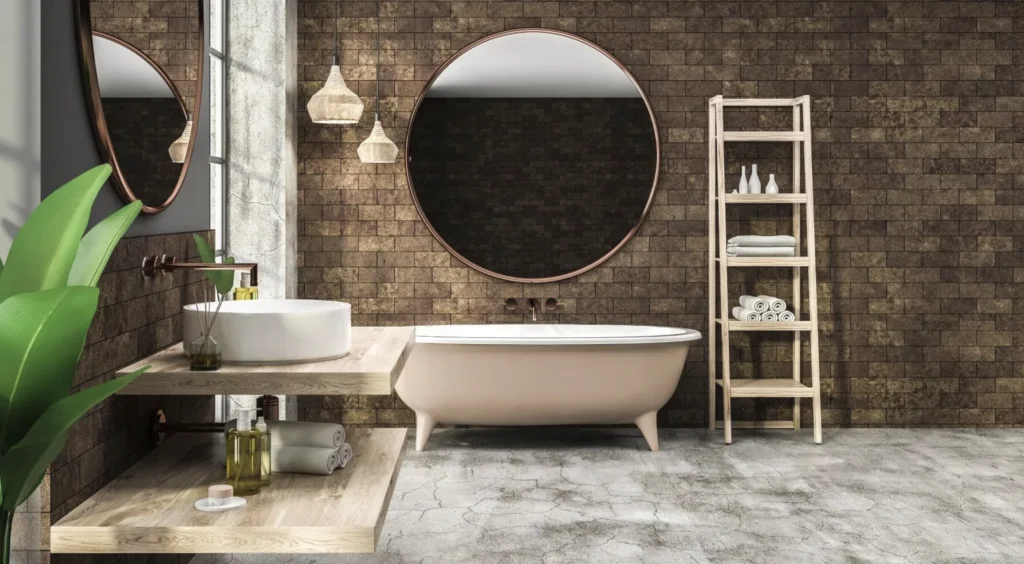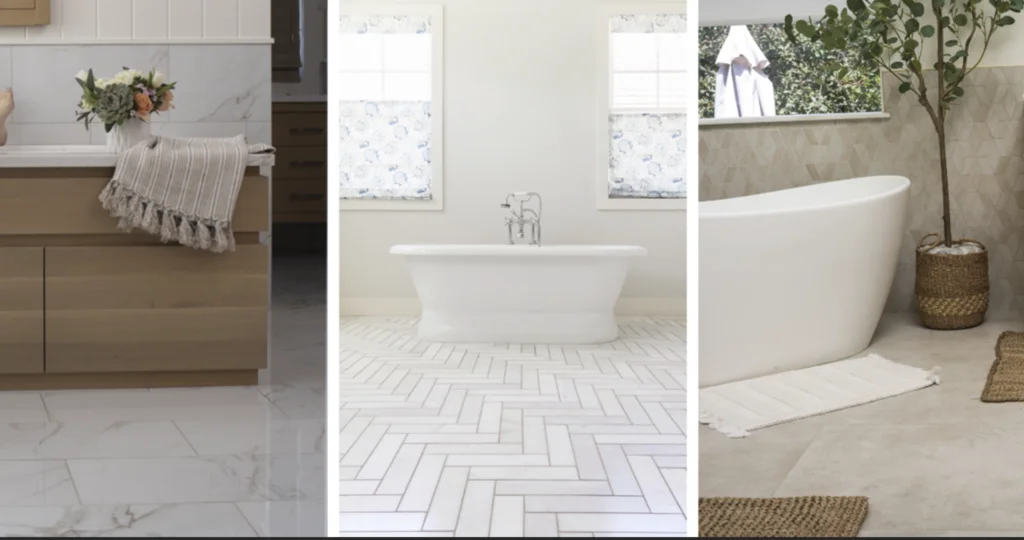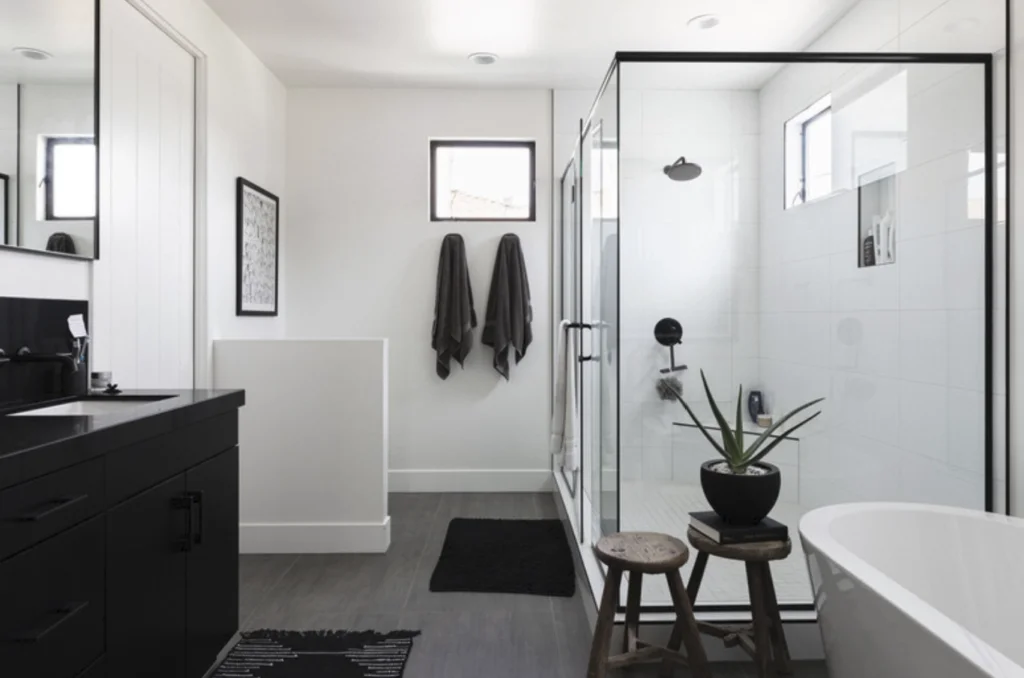Concrete flooring has made its way into some of the trendiest and most modern bathrooms, and for good reason. It’s no longer just for industrial settings; homeowners are now opting for this durable and stylish material in their personal spaces, especially bathrooms. But is it the right choice for your bathroom? In this article, we’ll explore the pros and cons of using concrete for bathroom floors to help you make an informed decision.
What is Concrete Flooring?

Concrete flooring, as the name suggests, is made from a mixture of cement, water, and aggregate materials like sand, gravel, or stone. In bathrooms, the surface is usually sealed or polished to create a smooth, durable, and water-resistant finish. It can be customized with stains, textures, and finishes, offering a wide range of design options.
Why Choose Concrete for Bathroom Floors?
If you’re looking for something unique, sturdy, and cost-effective, concrete flooring may be on your radar. It offers an industrial-chic aesthetic that many homeowners love. Not only that, concrete is incredibly durable and can stand up to moisture and wear and tear, which makes it an ideal choice for bathrooms.
Pros of Concrete Flooring in Bathrooms

1. Durability
Concrete is one of the toughest flooring materials out there. It can withstand heavy foot traffic, is resistant to scratching, and, if installed properly, can last for decades without needing to be replaced.
2. Water Resistance
Bathrooms are naturally damp environments, so having a water-resistant floor is crucial. Concrete floors, when properly sealed, are impervious to water, making them a great option for bathrooms.
3. Design Versatility
Concrete doesn’t have to be gray and boring. You can choose from polished, stained, or textured finishes, which allow you to tailor your bathroom’s style. Want a high-gloss, modern look? Opt for polished concrete. Prefer something more rustic? Staining or texturing the surface will give it a more earthy appeal.
4. Low Maintenance
With proper sealing, concrete floors are incredibly easy to clean. Spills, dirt, and grime can be wiped up quickly, and you won’t have to worry about grout lines or deep crevices where mold can form.
5. Cost-Effectiveness
Concrete flooring can be a budget-friendly option. If your home already has a concrete slab, you could simply refinish it, which would be less expensive than installing traditional tiles or other flooring materials.
Cons of Concrete Flooring in Bathrooms
1. Cold Underfoot
Concrete tends to feel cold underfoot, especially in winter months. However, this can be mitigated with the use of area rugs or installing underfloor heating systems, which we’ll discuss later.
2. Susceptibility to Cracking
Although durable, concrete can crack over time, especially if it’s not installed correctly or if the house foundation shifts. These cracks can sometimes be difficult to repair.
3. Requires Sealing
Concrete floors need to be sealed regularly to protect them from water, stains, and damage. Neglecting this can lead to moisture problems and even mold growth in the bathroom.
4. Slipperiness When Wet
Concrete can be slippery, especially when polished. Adding a textured finish or using non-slip mats can help to reduce the risk of accidents.
Design Options for Concrete Bathroom Floors
Concrete offers numerous design options, allowing you to customize your bathroom flooring to fit your style.
- Polished Concrete: A high-gloss finish that gives a sleek, modern look.
- Stained Concrete: Adds color and depth, perfect for a more natural, earthy feel.
- Textured Concrete: Provides additional grip and a rustic appearance.
Is Concrete Flooring Safe for Bathrooms?

Safety is always a concern in a bathroom, and the smooth surface of polished concrete may be slippery when wet. However, you can opt for textured finishes or add non-slip coatings to make the surface safer. Using bath mats around areas prone to getting wet is also a good idea.
Concrete Flooring Installation Process
Installing concrete flooring in your bathroom is a multi-step process:
- Step 1: Prepare the subfloor by cleaning and leveling it.
- Step 2: Pour the concrete mix and let it cure.
- Step 3: Apply the chosen finish (polishing, staining, or texturing).
- Step 4: Seal the floor to protect it from moisture.
While some DIY enthusiasts might want to try installing concrete floors themselves, it’s generally recommended to hire professionals, especially for bathrooms, where water resistance and durability are key.
Maintenance Tips for Concrete Bathroom Floors
Concrete floors are low-maintenance, but they still need care:
- Regular Cleaning: Use mild soap and water for routine cleaning.
- Resealing: You should reseal your concrete bathroom floor every 1-3 years to keep it water-resistant and looking its best.
Concrete vs. Tile: A Bathroom Flooring Comparison

Let’s compare concrete with tile, another popular bathroom flooring option:
- Durability: Both are durable, but concrete is more resistant to cracking under pressure.
- Aesthetic Options: Tiles come in various patterns, while concrete offers a more seamless, modern look.
- Maintenance: Concrete is easier to clean, with no grout lines to worry about.
- Cost: Concrete is generally cheaper, especially if you already have a concrete subfloor.
Can You Use Heated Flooring with Concrete?
Yes! One of the great things about concrete is that it works well with underfloor heating systems. This not only helps to keep your bathroom cozy but also eliminates the cold feel that concrete floors can sometimes have.
Environmental Impact of Concrete Flooring

While concrete is not the most eco-friendly material due to its high carbon footprint during production, it can be a sustainable choice. Its longevity means you won’t need to replace it for decades, and many modern concrete mixes use recycled materials.
Cost of Installing Concrete Floors in Bathrooms
The cost of installing concrete flooring can vary depending on the size of the bathroom, the type of finish you choose, and the complexity of the installation. On average, you can expect to pay between $6 to $12 per square foot for basic concrete floors, with more decorative finishes costing extra.
Real-Life Examples of Concrete Bathroom Flooring
Many modern homes and hotels are now using concrete flooring in their bathrooms. These floors add a sleek, industrial-chic look and are highly functional in high-moisture environments. Whether you’re aiming for a minimalist or bold design, concrete offers plenty of customization options to suit your style.
Conclusion
Concrete flooring in bathrooms can be a stylish, durable, and cost-effective option for homeowners. Its versatility, water resistance, and low maintenance make it a popular choice, although there are some drawbacks like coldness and the potential for cracking. Ultimately, whether or not concrete is the right choice for your bathroom depends on your personal preferences and budget.
FAQs
- What is the lifespan of concrete flooring in a bathroom?
- With proper care and maintenance, concrete floors can last for 50 years or more.
- How often should I reseal my concrete bathroom floor?
- It’s recommended to reseal every 1-3 years, depending on wear and water exposure.
- Is concrete a good option for small bathrooms?
- Yes! Concrete’s seamless design can make a small bathroom appear larger and more cohesive.
- Can I change the color of my concrete bathroom floor?
- Yes, you can stain or refinish your concrete floor to change its color or appearance.
- How can I prevent my concrete bathroom floor from becoming slippery?
- Adding texture to the surface or using non-slip coatings can help improve grip.
